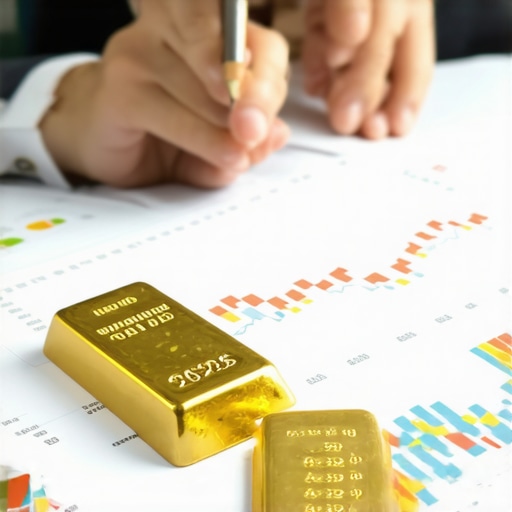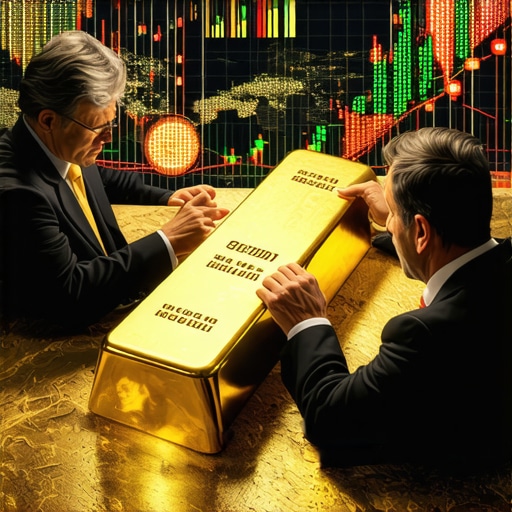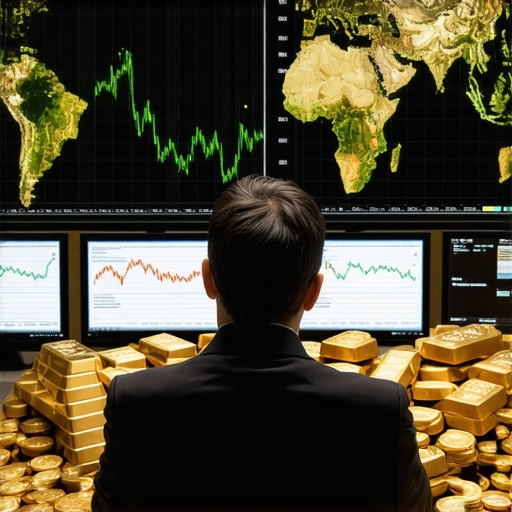Unveiling the Gold Demand Landscape: What 2029 Holds for Investors
As the global economy navigates shifting geopolitical tensions, inflationary pressures, and technological transformations, understanding gold demand trends becomes paramount for savvy investors aiming to secure and grow their wealth in 2029. Gold, long revered as a haven asset, is influenced by complex supply-demand dynamics that extend beyond mere market speculation. This article delves deep into emerging patterns and critical factors shaping gold’s trajectory, empowering investors with nuanced insights to make informed decisions.
Global Economic Shifts Driving Gold Demand in 2029
The interplay between inflation concerns and monetary policy remains a pivotal driver of gold demand. Central banks across emerging and developed economies have been increasing their gold reserves as a hedge against currency volatility and geopolitical risks, a trend forecasted to intensify throughout 2029. For example, the recent increase in central bank gold purchases underscores a strategic shift towards diversifying reserves beyond traditional fiat currencies. Investors should monitor these macroeconomic indicators closely, as they often presage shifts in gold pricing and availability.
How Do Technological and Industrial Uses Impact Gold Demand?
While gold’s role as a financial asset is well known, its industrial applications—particularly in electronics and green technologies—are emerging as significant demand drivers. The expansion of electric vehicles and renewable energy technologies requires high-purity gold for reliable conductivity and corrosion resistance, subtly altering the demand landscape. Such industrial consumption adds a layer of resilience to gold demand, which historically relied heavily on investment and jewelry sectors. Recognizing these nuanced demand streams can help investors anticipate market changes with greater precision.
Investor Behavior and Market Sentiment: Navigating 2029’s Gold Trends
Investor preferences are evolving with increased interest in diversified gold investment vehicles such as ETFs, mutual funds, and physical bullion. The surge in gold-backed ETFs illustrates a democratization of gold investment, offering liquidity without sacrificing exposure to the metal’s price movements. Moreover, geopolitical uncertainties and inflation fears continue to drive retail and institutional investors alike towards gold as a portfolio stabilizer. Savvy investors will benefit from understanding these behavioral trends alongside traditional supply-demand fundamentals.
Supply Constraints and Sustainability Challenges Influencing Gold Prices
On the supply side, mining output is facing constraints due to resource depletion, rising extraction costs, and environmental regulations. Sustainable mining practices and the push for ethical sourcing are reshaping how gold is produced and marketed. These factors contribute to supply tightness, potentially elevating prices and shifting investor focus towards responsibly sourced gold products. Awareness of sustainability issues is increasingly vital for investors seeking both financial returns and alignment with environmental, social, and governance (ESG) criteria.
Harnessing Gold Demand Trends: Strategic Insights for Smart Investing
To capitalize on these evolving dynamics, investors should adopt a multi-faceted approach: combining physical gold holdings with exposure to ETFs or mutual funds tailored for 2029’s market realities. Diversification within gold assets mitigates risk while optimizing returns amid volatility. Additionally, keeping abreast of central bank activities and emerging industrial demand can provide early signals for market entry or exit. For practical guidance on navigating these opportunities, explore detailed strategies on understanding gold demand trends and their impact on prices in 2029.
Join the Conversation: Share Your Perspective on Gold’s Future
How do you see gold demand evolving in 2029? Share your thoughts or questions below to engage with a community of informed investors and experts. Staying connected and informed is key to mastering gold market complexities.
For a comprehensive dive into analyzing gold price forecasts and making smarter investment decisions, visit this authoritative guide by industry experts.
Reflecting on the Impact of Central Bank Gold Purchases
One thing I’ve learned from my experience tracking gold trends is just how influential central bank activities are. When these institutions ramp up their gold reserves, it’s not just a quiet transaction — it sends ripples across the global market. In 2029, central banks are expected to be even more active buyers, especially in regions seeking to diversify away from dollar dependency. Watching these moves closely has helped me anticipate shifts in price and market sentiment. According to the World Gold Council, central banks purchased over 600 tons of gold in recent years, underscoring their growing appetite for this safe haven asset, which aligns with the trends I’ve observed personally.
Personal Strategies for Balancing Physical Gold and ETFs
From my journey as an investor, I’ve found that a balanced approach to gold investments offers the best of both worlds. Physical gold — whether coins or bars — provides a tangible sense of security, especially during times of uncertainty. However, it does come with storage considerations and liquidity challenges. On the other hand, gold-backed ETFs offer flexibility and ease of trading, letting me respond quickly to market shifts without dealing with physical storage. If you’re curious about how to compare these options, I highly recommend checking out this guide on comparing gold ETFs and mutual funds for a detailed breakdown.
How Can Investors Stay Ahead of Emerging Gold Demand Drivers?
It’s a question I often ask myself, especially as industrial demand for gold evolves with technology. The rise of electric vehicles and 5G networks creates fresh demand for gold in circuit boards and connectors. This industrial pull, coupled with traditional investment demand, means the gold market is becoming more multifaceted. My advice? Keep an eye on sectors like green technology and electronics — they might just influence gold prices more than you expect. Staying informed through trusted sources like the World Gold Council can provide valuable insights into these demand shifts.
Embracing Sustainability in Gold Investing
Another personal reflection is the importance of sustainability. Today’s investors, including myself, increasingly consider ESG factors when selecting gold products. Ethical sourcing and environmentally responsible mining aren’t just buzzwords; they can affect supply stability and long-term value. I’ve made it a point to explore companies and funds prioritizing sustainable practices, which not only aligns with my values but also helps mitigate risks associated with regulatory changes and reputational challenges.
Engage and Share Your Gold Investment Journey
Gold investing is a continually evolving journey. I’d love to hear about your experiences, questions, or strategies. Have you found a sweet spot between physical gold and ETFs? How are you factoring in new demand drivers or sustainability? Drop a comment below or share this article with fellow investors who might benefit from these insights. And if you want to deepen your understanding, exploring our beginner’s guide to investing in gold can be a great next step.
Decoding Industrial Gold Demand: Beyond Traditional Investment and Jewelry
In 2029, the gold market’s complexion is being reshaped by industrial innovations that extend well beyond its historic roles in investment and ornamentation. High-purity gold’s unparalleled electrical conductivity and resistance to corrosion make it indispensable in the burgeoning sectors of electric vehicles (EVs), 5G telecommunications, and renewable energy technologies such as solar panels and hydrogen fuel cells. These industries demand precise quantities of gold embedded within complex components like printed circuit boards, connectors, and catalytic converters.
The intricate supply chain for industrial gold involves challenges such as refining standards, traceability, and integration with emerging manufacturing techniques like 3D printing of electronics. These factors create nuanced fluctuations in demand that investors must monitor alongside macroeconomic trends. For instance, a surge in EV production driven by government subsidies or breakthroughs in battery technology could directly translate into increased gold consumption, potentially tightening supply and influencing price dynamics.
What Are the Implications of Recycling and Urban Mining on Gold Supply in 2029?
As sustainability concerns escalate, recycling and urban mining have emerged as critical components of the gold supply ecosystem. Urban mining—recovering gold from electronic waste and obsolete devices—offers a promising supplement to traditional mining but comes with technological and economic hurdles. Advanced recycling methods employing hydrometallurgy and bioleaching aim to enhance recovery rates while minimizing environmental footprints.
However, the scale of recycled gold currently meets only a fraction of global demand. The World Gold Council highlights that recycled gold accounted for approximately 28% of total supply in recent years, a figure poised to grow but unlikely to fully offset diminishing mine outputs by 2029. Investors should, therefore, factor in these supply-side nuances when evaluating gold’s long-term price trajectory and consider how innovations in recycling technologies might mitigate supply constraints over time (World Gold Council: Recycling and Urban Mining Insights).
Strategic Portfolio Positioning Amid ESG and Regulatory Paradigm Shifts
Environmental, Social, and Governance (ESG) criteria have transitioned from peripheral considerations to core pillars influencing investment decisions. In 2029, gold producers face heightened scrutiny regarding mining practices, labor conditions, and community impact. This regulatory tightening has led to increased costs but also opened avenues for premium pricing of responsibly sourced gold.
Investors are increasingly drawn to ESG-compliant gold ETFs and funds that transparently report on sourcing and sustainability metrics. These vehicles not only align portfolios with ethical standards but may also offer resilience against reputational risks and regulatory penalties. Understanding the interplay between ESG trends and gold supply-demand fundamentals is crucial for advanced investors aiming to future-proof their holdings.
How Do Geopolitical Tensions Influence Central Bank Gold Reserves and Market Stability?
Geopolitical dynamics remain a powerful catalyst for central bank gold purchasing behaviors. In periods of heightened international tension or trade uncertainty, central banks often amplify gold acquisition to bolster reserve diversification and hedge against currency depreciation. Such strategies can induce notable market ripples, affecting liquidity and price volatility.
Moreover, shifts in global alliances and sanctions regimes may alter gold trade flows, influencing both official reserves and private sector availability. For instance, emerging economies seeking to reduce reliance on dominant currencies might accelerate gold accumulation, reinforcing its status as a strategic asset. Sophisticated investors need to integrate geopolitical risk assessments into their analytical frameworks to anticipate these supply-demand shocks effectively.
Deepening Expertise: Leveraging Data Analytics and Market Intelligence for Gold Investment
In the contemporary investment landscape, harnessing data analytics tools and real-time market intelligence platforms is indispensable for dissecting complex gold demand drivers. Predictive analytics can model correlations between industrial production indices, central bank activities, and ETF flows, unveiling early warning signals for price movements.
Advanced investors might employ machine learning algorithms to track sentiment analysis from financial news, social media, and geopolitical event databases, enhancing timing and allocation decisions. Continuous education and engagement with authoritative sources, such as the World Gold Council’s detailed reports and market briefs, provide an essential knowledge edge.
If you’re committed to mastering gold investment in 2029’s multifaceted environment, consider subscribing to specialized newsletters and joining professional investor forums where expert discourse and cutting-edge research converge.
Innovative Industrial Applications: Gold’s Expanding Technological Footprint
Beyond its traditional allure as a store of value and ornamental metal, gold’s utility in cutting-edge industrial sectors is redefining its demand profile in 2029. The proliferation of electric vehicles (EVs), 5G infrastructure, and renewable energy solutions such as photovoltaic cells and hydrogen fuel technologies increasingly rely on gold’s superior electrical conductivity and corrosion resistance. These sectors require precise gold quantities embedded within microelectronic components, driving a nuanced demand that challenges conventional investment paradigms and necessitates a sophisticated understanding of supply chain intricacies.
How Will Advances in Recycling and Urban Mining Reshape Gold Supply Chains?
The surging imperative for sustainability has catapulted recycling and urban mining to the forefront of gold supply considerations. Urban mining involves extracting gold from discarded electronics, presenting a promising avenue to supplement dwindling mine outputs. Innovations in hydrometallurgical processes and bioleaching aim to elevate recovery rates while mitigating environmental impact. However, despite recycled gold currently constituting approximately 28% of total supply according to the World Gold Council’s Recycling and Urban Mining Insights, technological and economic constraints limit its ability to fully offset supply shortages. Investors must weigh these developments carefully when projecting gold’s future price trajectories.
Integrating ESG Imperatives into Gold Investment Strategies
The integration of Environmental, Social, and Governance (ESG) criteria has transcended peripheral interest to become a decisive factor in gold investment frameworks. Heightened regulatory scrutiny compels mining entities to adopt sustainable practices, with an emphasis on ethical labor standards, community engagement, and environmental stewardship. This transformation not only increases operational costs but creates market differentiation opportunities through premium pricing of responsibly sourced gold. ESG-compliant ETFs and funds now offer investors avenues to align financial objectives with ethical commitments while potentially mitigating reputational and regulatory risks in volatile markets.
Geopolitical Undercurrents: Central Bank Gold Reserves as Strategic Levers
Geopolitical tensions remain a pivotal influence on central bank gold acquisition policies and global market stability. In scenarios of escalating international discord or currency volatility, central banks intensify gold purchases to diversify reserves and shield economies from external shocks. Such behavior can induce volatility spikes and liquidity constraints in gold markets. Emerging economies’ strategic moves to diminish reliance on dominant fiat currencies by augmenting gold reserves further underscore gold’s geopolitical significance. For investors, incorporating geopolitical risk analytics is indispensable for anticipating supply-demand shocks and optimizing portfolio resilience.
Harnessing Data Analytics and AI: The Frontier of Gold Market Intelligence
The complexity of gold demand drivers in 2029 necessitates leveraging advanced data analytics and artificial intelligence (AI) to extract actionable insights. Predictive modeling that correlates macroeconomic variables, industrial production indices, and sentiment analysis from global news and social media enables more precise forecasting of price movements. Machine learning algorithms facilitate the detection of subtle market signals and geopolitical developments, empowering investors to refine timing and allocation strategies. Engagement with authoritative repositories like the World Gold Council and subscription to specialized intelligence platforms can significantly elevate decision-making acumen.

Elevate Your Gold Investment Acumen
To navigate the multifaceted gold landscape of 2029 effectively, integrating cutting-edge knowledge on industrial demand, sustainability, geopolitical factors, and data analytics is imperative. I invite you to deepen your expertise by exploring advanced resources and engaging with a community of sophisticated investors who share insights and strategies. Harness these insights today to position your portfolio advantageously amid evolving gold market dynamics.
Frequently Asked Questions (FAQ)
What factors primarily drive gold demand in 2029?
Gold demand in 2029 is influenced by a multifaceted set of factors including central bank reserve policies, investor sentiment driven by inflation and geopolitical risks, expanding industrial applications especially in technology and green energy sectors, supply constraints from mining and recycling, and increasing emphasis on ESG-compliant sourcing. Understanding these drivers holistically is key to anticipating price and demand shifts.
How significant is the role of industrial demand compared to traditional investment and jewelry sectors?
Industrial demand is becoming increasingly significant, fueled by the rise of electric vehicles, 5G telecommunications, and renewable energy technologies that require high-purity gold for critical components. While investment and jewelry remain major sectors, industrial consumption adds a resilient and growing layer that diversifies gold’s demand base and impacts supply dynamics.
Can recycling and urban mining substantially ease gold supply shortages?
Recycling and urban mining are important supplements to gold supply, recovering gold from electronic waste and obsolete devices. However, current recycling accounts for around 28% of total supply and faces technological and economic constraints. While advances in hydrometallurgy and bioleaching may improve recovery rates, recycled gold alone is unlikely to fully offset declining mine outputs by 2029.
How do ESG considerations affect gold investment strategies?
ESG factors have become central to gold investing, influencing mining practices, regulatory compliance, and product sourcing. Investors increasingly prefer ESG-compliant gold ETFs and funds that emphasize ethical labor conditions, environmental stewardship, and community engagement. Such alignment can mitigate reputational and regulatory risks while potentially commanding premium pricing for responsibly sourced gold.
What impact do geopolitical tensions have on gold market stability?
Geopolitical tensions often prompt central banks to increase gold reserves as a strategic hedge, affecting global supply and demand balance. Shifts in alliances, sanctions, and currency policies can alter gold trade flows and market liquidity, leading to price volatility. Investors need to incorporate geopolitical risk analysis to anticipate such supply-demand shocks effectively.
Why is combining physical gold holdings with ETFs recommended?
Combining physical gold with ETFs balances tangible security and liquidity. Physical gold offers direct ownership and a hedge against systemic risks but involves storage and liquidity challenges. ETFs provide ease of trading and diversification without physical handling. This multi-faceted approach optimizes risk management and responsiveness to market changes.
How can data analytics and AI improve gold investment decisions?
Advanced analytics and AI enable investors to model complex relationships among macroeconomic variables, industrial production, central bank activity, and market sentiment. Machine learning algorithms detect subtle trends and geopolitical events influencing gold prices, facilitating more precise timing and allocation. Engaging with data-driven market intelligence enhances investment outcomes in a complex environment.
What should new investors know before entering the gold market in 2029?
New investors should understand gold’s diverse demand drivers, including emerging industrial uses and ESG trends. They should weigh options between physical gold and financial instruments like ETFs, consider geopolitical and economic contexts, and stay informed through reputable sources. Starting with a clear strategy, diversification, and education is essential for long-term success.
How do central bank gold purchases influence price trends?
Central bank gold acquisitions reflect strategic reserve diversification, often increasing during times of economic uncertainty or geopolitical risk. Such purchases reduce available market supply and signal confidence in gold as a safe haven, typically exerting upward pressure on prices. Monitoring these activities provides valuable foresight into market sentiment and potential price movements.
What role does sustainability play in future gold supply chains?
Sustainability reshapes gold supply chains through stricter environmental regulations, ethical labor practices, and demand for transparency. Mining operations must adopt responsible practices, which can increase costs but also create value differentiation. Sustainable sourcing is becoming a criterion for investors and consumers alike, influencing both supply stability and market preferences.
Trusted External Sources
- World Gold Council (WGC): The leading authority on gold market data, investment trends, recycling insights, and ESG standards. Its comprehensive research, such as reports on recycling and industrial demand, provides invaluable data and analysis for investors.
- International Council on Mining and Metals (ICMM): Offers detailed guidance on sustainable mining practices and governance, informing investors about environmental and social responsibility in gold production.
- International Monetary Fund (IMF): Provides macroeconomic data and reports on central bank reserve management and geopolitical risk that influence gold demand and pricing globally.
- Bloomberg Intelligence – Metals & Mining: Delivers market intelligence, predictive analytics, and real-time data on gold supply, demand, and price movements, integrating financial and geopolitical factors.
- Journal of Sustainable Finance & Investment: Publishes peer-reviewed research on ESG integration in commodity markets, including gold, offering advanced perspectives on ethical investing trends.
Conclusion
Gold demand in 2029 is shaped by a complex convergence of factors spanning economic policy, technological innovation, sustainability imperatives, and geopolitical developments. Industrial applications in emerging technologies are augmenting traditional investment and jewelry demand, while supply challenges emphasize the importance of recycling and responsible sourcing. Central bank actions and investor behavior continue to influence market dynamics, making a comprehensive, data-driven approach essential for smart investing.
By integrating insights on ESG trends, leveraging advanced analytics, and balancing physical and financial gold holdings, investors can adeptly navigate the evolving gold landscape. Staying informed through reputable sources and engaging with expert communities further enhances decision-making precision.
Embrace these expert insights to position your portfolio strategically and confidently in 2029’s gold market. Share your perspectives, explore related expert content, and apply this knowledge to unlock gold’s full investment potential.











This comprehensive analysis really highlights how multifaceted the future of gold demand is, especially with the rising industrial uses in tech and green energy. I’ve personally been exploring opportunities in ESG-aligned gold ETFs, as I believe they not only align with my values but could also provide some resilience against regulatory risks and potential supply constraints. It’s impressive to see how recycling efforts, while still a smaller part of the overall supply, are gaining ground due to technological advances. Has anyone here experimented with combining recycled gold investments in their portfolio? I’m curious about practical strategies for integrating responsibly sourced metals, especially given the increasing emphasis on sustainability from both regulators and consumers. Also, with central banks expected to continue buying aggressively, how do you see this impacting price volatility in the next few years? Would love to hear different insights or experiences from fellow investors navigating these complex dynamics.